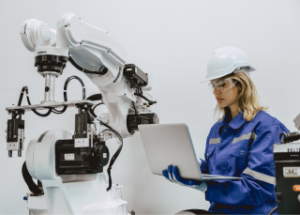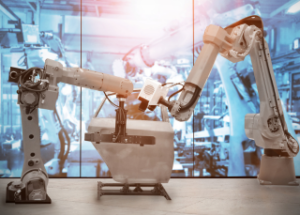The term “collaborative robots” (“Cobots”) refers to power and force limited robots that are equipped with very accurate and safety approved force sensing  capabilities. Collaborative robots can sense unexpected force and stop their motion very quickly if any abnormalities are found. Although they cannot always avoid bumping into humans, collaborative robots reduce the impact, preventing crushing and impact injuries. This makes Cobots far safer for human-scaled operations since they can work alongside humans and, in the case of human contact, will not severely injure anyone.
capabilities. Collaborative robots can sense unexpected force and stop their motion very quickly if any abnormalities are found. Although they cannot always avoid bumping into humans, collaborative robots reduce the impact, preventing crushing and impact injuries. This makes Cobots far safer for human-scaled operations since they can work alongside humans and, in the case of human contact, will not severely injure anyone.
OSHA requires that all industrial and collaborative robot applications comply with Robotics Industry Association (RIA) requirements and applicable ANSI, NFPA, and U.S. consensus standards as needed to ensure a hazard-free workplace. RIA 15.06 requires that all robot applications (industrial and collaborative) have a formal Risk Assessment performed. In addition, collaborative robot application safety standards, such as RIA 15.806, require that specific functional safety validation testing is performed before placing the robotic system into production. Machine Safety Specialists (MSS) understands the safety requirements for industrial and collaborative robot applications and our certified safety engineers are prepared to help you with these requirements.
Before releasing the collaborative robot application to production, an ANSI/RIA compliant risk assessment and specific documentation are required. Machine Safety Specialists (MSS) can guide you through this process and can train your team to do this correctly on current and future projects. MSS engineers are trained and certified to provide safety engineering services, including industrial and collaborative robot applications. In addition, our Machine Safety Training Program can be customized to include collaborative robot applications and Machine Safety Risk Assessments.
When the design is complete, and before installing the robotic system, MSS’ safety engineers provide safety verification services. In this design phase of the project, we review (verify) your design drawings, including electrical, pneumatic and hydraulic schematic drawings as well as Bills of Material (BoMs) for compliance with OSHA, ANSI/RIA, NFPA, and EN/ISO safety standards. Our safety engineers are able to perform SISTEMA analysis, if required, to verify the functional safety performance on the system. At this point in the project, our engineers can interface with your team and provide assistance keeping the design on-track and in compliance with required safety standards.
When the machine is built, we travel to the site to validate (test) the collaborative robot safety application and perform a safeguarding compliance audit. This safety validation includes safety controls, mechanical limits, tooling and fixtures, safeguarding, and typically also include functional safety integration(s) with other machines. These tests may include critical safety functions such as safety-rated monitored stop (SRMS), power and force limiting (PFL), speed and separation monitoring (SSM), and, if equipped, proper operation of hand-guided controls. Also, upon request, our safety engineers can provide calibrated quasi-static and transient contact tests using specialized, calibrated test equipment. All test results and any findings are shown in a comprehensive machinery safety test report.
By involving Machine Safety Specialists (MSS) early in the project, we ensure a safe and smooth production release of your collaborative robot application. Our certified safety engineers and training team is prepared to support your team with Machine Safety and Risk Assessment Training, safety design verification and safety validation services. Let us know how we can help ensure your robotics and machines comply with the latest safety standards. We’re standing by to meet your machine safety needs.
Risk assessments must be done with any type of industrial machine, whether it is an industrial robot or a collaborative robot (“Cobot”). Risk assessments are especially important for collaborative robots since they operate autonomously and may operate without any type of fence or guarding. Such risk assessments and resulting risk reduction measures greatly reduce the risk of a robot/human impact injury.
Most robotic safety requirements are taken from standards that are specific to industrial robots. The robotic industry has standards specific to collaborative robots that provide guidelines on the amount of force, pressure, and energy allowable for safe human interaction.
End users and integrators are required to complete risk assessments to prove that risks associated with the robotic application are within acceptable levels.
The term “robotic application” is important, because while the robot itself may have low risk, the entire robotic cell must be considered regarding its particular risks. If the robot has a hot or sharp surface as its end-of-arm tool, it may be dangerous for personnel working nearby. This is why all the aspects of a robotic cell have to be taken into consideration when doing a risk assessment.
Collaborative Robots (“Cobots”) are designed to work effectively directly alongside people in a factory setting, making it possible to deploy in environments which have historically been off-limits to robotic automation. Collaborative Robots combine a number of unique technologies designed to allow deployment without some of the traditional safeguarding described in ANSI, ISO, or other safety standards, based on the application’s risk assessment. Collaborative Robots are designed for:
ANSI/RIA R15.06-2012, applicable in the U.S., is an ANSI/RIA adoption of ISO 10218-1 & 2. Collaborative Robots are power and force limited by inherent design as described in ANSI/RIA R15.06-2012 and ISO 10218-1: 2011. The most recent edition of ISO 10218-1 does not include these power and force limiting collaborative requirements, but instead points to the requirement in ISO 10218-2 requiring a risk assessment of the entire robotic application, and refers readers to Technical Specification ISO TS 15066:2016 for further guidance.